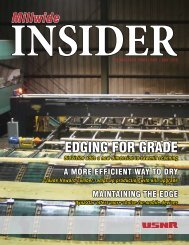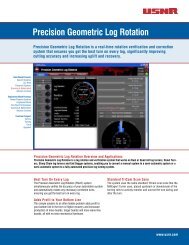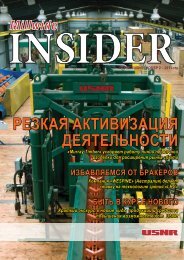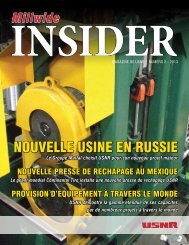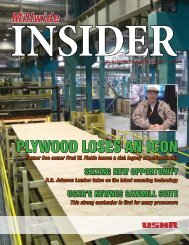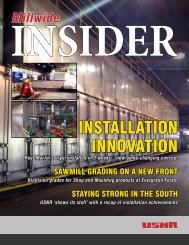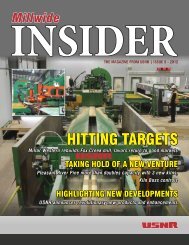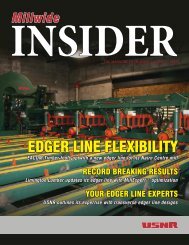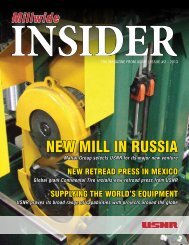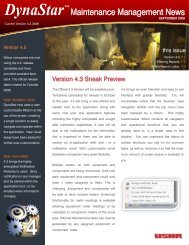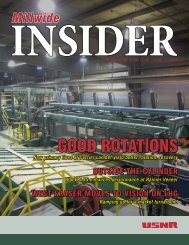You also want an ePaper? Increase the reach of your titles
YUMPU automatically turns print PDFs into web optimized ePapers that Google loves.
INNOVATIVENEWS O L U T I O N STECHNOLOGY SESSION: veneer dryer optimizationindustry’s most advanced VENEER DRYER systemThis technology session was presented by TimFisher, Business Development Manager for USNR’sVeneer/Plywood business. Tim discussed the historyand development of several technology advances inveneer drying. Processors who have applied thesetechnologies are reaping the benefits of reducedoperational costs and greater efficiency, improvedproduct quality and reduced emissions.USNR recently won an award for its veneer dryerinnovation. See page 13 for information.ADEC developmentExhausting dryers at the lowest temperature pointduring the process dramatically improves the thermalefficiency of the dryer. This concept has evolvedsince its inception. Because the lowest temperaturepoint (wet end of the process) also equates to a highlevel of moisture evaporation, a wet end seal sectionlocated at the infeed to the main dryer section isone of the key design elements. This single pointexhaust (SPE) feature allows the system to pull allthe process air from the dryer to one region to beexhausted. This patented concept has been coinedAutomatic Dryer Exhaust <strong>Co</strong>ntrol (ADEC). Dryersequipped with the ADEC system have been proven toincrease productivity, reduce thermal energyrequirements and reduce exhaust flow.Results of adding an ADEC system toyour dryer►►10-15% Exhaust flow reduction►►5-10% Thermal energy reduction►►8-10% Productivity increaseKey design elementsA secondary heating system in the wet end seal(WES) section maintains a high temperature as thegasses are mixed, thus ensuring that the volatileorganic compound-laden gases (VOCs) remain ingaseous form as they are exhausted from the dryer.This also alleviates pitch build up. Temperature datagathered at the top of the WES section, the point ofair intake from the dryer section, and the point ofambient air intake from the plant, allows the ADECsystem to precisely control the amount of heatingof the air mixture inside the WES section prior toexhaust. This is key to maximizing thermal efficiency.Achieve greater benefit with <strong>Co</strong>olerPressure Balance►►Improves control of dried veneer temperature►►Reduces VOCs in the cooler vent►►Reduces pitch build-up in dryer / cooler sections►►Further improves thermal efficiencyAnother key element to optimizing dryer operation isthe control of the cooler exhaust volume, to minimizethe flow of heated air from the dryer into the coolersection, or cooler air into the hot dryer. This patented<strong>Co</strong>oler Pressure Balance (CPB) system further helpsto maximize thermal efficiency, minimizes pitchbuildup which reduces maintenance and cleaning, andallows for automatic veneer temperature control intothe dry veneer stacking process.Pressure sensing manifolds accurately measurethe pressure in the last heated dryer section and firstcooling section. Any pressure difference commandsa change in the cooling section exhaust fan speed.The effect is a near zero pressure differential betweenthe dryer and the first cooler section.WHAT IS ADEC, AND HOW DOES IT WORK?Ambientplant airVeneerflowWET ENDSEALExhaust flowHot dryer airDRYER►►Maximize productivity►►Maximize veneer quality►►Minimize exhaust volumeCOOLINGSECTIONS►►Reduce thermal energy requirements►►Reduce hydrocarbon build-up►►Improve working environmentADEC allows automatic control of the total dryerexhaust volume, and maximizes the thermalefficiency of the process. Based on set values,ADEC uses the temperature differential betweenthe ambient plant air and the wet end sealsection to adjust the main dryer exhaust damper.This, in turn, exhausts more or less air volumefrom the dryer section. The exhausted air is thendirected through a duct to the plant’s pollutionabatement equipment.The temperature differential is also a trueindication of the exhaust requirement of thedryer. When the wet end seal temperature risesabove a control set point, it indicates thatpressure (air volume caused by evaporation ofwater from the veneer) is increasing in the dryer,and vice versa. ADEC continually adjusts theexhaust flow to prevent fugitive emissions andover-exhausting the dryer, while also maximizingthe absolute humidity within the dryer.18Millwide INSIDER | ISSUE 6 - <strong>2012</strong>



